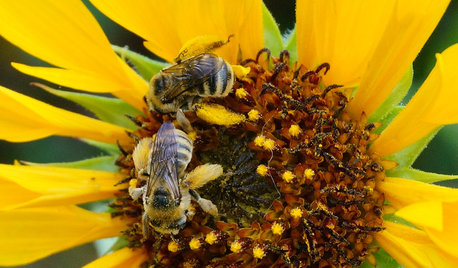Honey bees are no angels
alan haigh
12 years ago
Related Stories

EARTH DAY12 Entertaining ‘Bee-haviors’ of Native Bees
The parade of pollinator antics is another reason to create a garden that nurtures native bees
Full Story
FARM YOUR YARDHello, Honey: Beekeeping Anywhere for Fun, Food and Good Deeds
We need pollinators, and they increasingly need us too. Here, why and how to be a bee friend
Full Story
GARDENING GUIDESSmall Carpenter Bees Are Looking for a Home in Your Plant Stems
Provide flowers and nesting sites in your garden for this beautiful, tiny, metallic blue wild bee — your plants will thank you
Full Story
SHOP HOUZZShop Houzz: The Birds and the Bees
Give your home some seasonal buzz with whimsical accents inspired by the birds and bees
Full Story
GARDENING FOR BUTTERFLIESGardening for the Bees, and Why It’s a Good Thing
When you discover how hard bees work for our food supply, you may never garden without them in mind again
Full Story
EARTH DAYHow to Design a Garden for Native Bees
Create a garden that not only looks beautiful but also nurtures native bees — and helps other wildlife in the process
Full Story
GARDENING GUIDESInvite Cellophane Bees to Your Garden by Providing Patches of Bare Soil
Look for cellophane bees (Colletes) pollinating flowering trees and shrubs in U.S. gardens this spring
Full Story
GARDENING GUIDES15 Native Flowers That Feed Native Bees
These perennials offer superfood to hundreds of bees and are gorgeous in their own right
Full Story
SHOP HOUZZShop Houzz: Get the Buzz on the Bee Motif
Inject a bee-dazzling energy into your rooms with bees, honeycombs and hive motifs
Full Story
GARDENING GUIDESInvite Mining Bees to Your Garden by Planting Their Favorite Plants
Look for mining bees (Andrena) pollinating woodland wildflowers in U.S. gardens this spring
Full StorySponsored
Most Skilled Home Improvement Specialists in Franklin County
More Discussions








trianglejohn
ericwi
Related Professionals
Havre de Grace Landscape Architects & Landscape Designers · Salem Landscape Architects & Landscape Designers · Williamsburg Landscape Contractors · Belvedere Park Landscape Contractors · Bergenfield Landscape Contractors · Blue Springs Landscape Contractors · Cedar Hill Landscape Contractors · Dedham Landscape Contractors · Hoover Landscape Contractors · Lewisville Landscape Contractors · Marlborough Landscape Contractors · North Ridgeville Landscape Contractors · Pompton Lakes Landscape Contractors · Roseville Landscape Contractors · San Pablo Landscape Contractorsgonebananas_gw
jean001a
alan haighOriginal Author
theaceofspades
alan haighOriginal Author
theaceofspades
alan haighOriginal Author
Konrad___far_north
alan haighOriginal Author
mc25a
theaceofspades
alan haighOriginal Author
Noogy
austransplant
alan haighOriginal Author
mc25a
alan haighOriginal Author
Noogy
ltilton
Noogy
planatus
alan haighOriginal Author
jayanem
alan haighOriginal Author
galagala
alan haighOriginal Author
plumhillfarm
Charlie
drew51 SE MI Z5b/6a
alan haighOriginal Author
canadianplant
Voyage034
alan haighOriginal Author
Charlie
olpea
alan haighOriginal Author
Dan.NY
alan haighOriginal Author
mes111
Dan.NY
mrsg47
Konrad___far_north
bucky130
fusion_power
kerk4321
milehighgirl
alan haighOriginal Author
megan_anne